Introduction
Protected areas form the central pillar of conservation strategies worldwide and covered at least 12.9% of the world’s land surface by 2009 (Jenkins & Joppa, Reference Jenkins and Joppa2009). These areas are highly diverse in terms of their nomenclature, scale, spatial context, governance models, management objectives and management approaches, and great variation therefore exists in protected areas both within and between countries. Attempts to apply a descriptive framework to this array of approaches date back to 1933 (Phillips, Reference Phillips2004) and culminated in IUCN’s Guidelines for Protected Area Management Categories (IUCN, 1994). Revised and updated in 2008 (Dudley, Reference Dudley2008a), the IUCN category system is now recognized by governments (Dillon, Reference Dillon2004) and conservation institutions as a unifying framework for the description, definition and comparison of the world’s protected areas, and its use is endorsed and encouraged by the Programme of Work on Protected Areas of the Convention on Biological Diversity (SCBD, 2004). The system classifies protected areas into six main categories (Dudley, Reference Dudley2008a; Dudley et al., Reference Dudley, Parrish, Redford and Stolton2010), based on their primary management objective (Table 1).
Table 1 IUCN definitions of protected area categories.
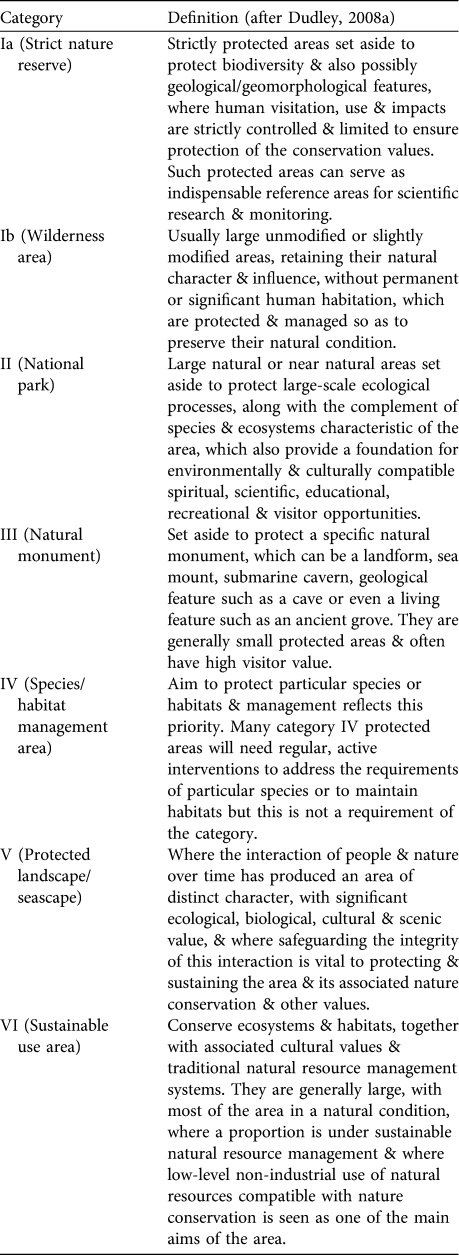
Of the six management categories within the IUCN system, it is category V that has attracted much attention and debate (Locke & Dearden, Reference Locke and Dearden2005; Martino, Reference Martino2005, Mallarach et al., Reference Mallarach, Morrison, Kothari, Sarmiento, Atauri, Wishitemi, Dudley and Stolton2008). The establishment of the World Commission on Protected Areas Category V Task Force and the publication of a number of outputs intended to clarify and promote the approach are testament to this debate. Uniquely among the six categories, category V focuses specifically on areas in which there has been a historical interaction between people and nature (Phillips, Reference Phillips2002), and where this interaction has produced the landscape characteristics that are the objects of the conservation intervention. The primary objective of the approach is to ‘protect and sustain important landscapes/seascapes and the associated nature conservation and other values created by interactions with humans through traditional management practices’. Contrary to other categories, where the emphasis of management is placed on protecting what is seen as natural, the category V approach ‘puts people at the heart of the operation—and indeed requires them to be there’ (Phillips, Reference Phillips2002, p. 5). This idea is further developed in the IUCN guidelines (Dudley, Reference Dudley2008a, p. 21). Among the distinguishing features listed for category V ‘a balanced interaction between people and nature that has endured over time and still has integrity’ is stated as an essential characteristic. The core management philosophy of the approach (Phillips, Reference Phillips2002, p. 10) is to ‘maintain the harmonious interaction of people and nature’.
The protected landscapes approach has been better established in Europe than elsewhere because of the continent’s long history of settlement, the lack of remaining large natural areas, and the existence of many cultural landscapes with significant natural values (Phillips, Reference Phillips2002). As a category that reflects the increasingly dominant conservation paradigm (Büscher & Whande, Reference Büscher and Whande2007) of integrating local people into conservation initiatives and encouraging sustainable use rather than strict preservation (Wells & McShane, Reference Wells and McShane2004; Locke & Dearden, Reference Locke and Dearden2005; Naughton-Treves et al., Reference Naughton-Treves, Buck Holland and Brandon2005) the category V model is seen as ‘an approach whose time has come’ (Phillips, Reference Phillips2002, p. 13), and the application of the category and its management principles has been strongly promoted for adoption globally. To some extent, this reflects the fact that most large wilderness or natural areas have already been incorporated into protected areas (Leroux et al., Reference Leroux, Krawchuk, Schmiegelow, Cumming, Lisgo, Anderson and Petkova2010), and remaining areas available for new protected area creation often include substantial human populations whose needs must be reflected in appropriate management objectives and approaches (Hutton & Leader-Williams, Reference Hutton and Leader-Williams2003; Mallarach et al., Reference Mallarach, Morrison, Kothari, Sarmiento, Atauri, Wishitemi, Dudley and Stolton2008).
Here I seek to contribute to the process of reviewing the IUCN category system (recommended by Dudley et al., Reference Dudley, Harrison and Rosabal2004, Reference Dudley, Parrish, Redford and Stolton2010, to ensure that protected areas can adapt and respond to global challenges) by examining the application of categories within the context of Madagascar’s rapidly expanding protected area system. I first provide a brief history of protected areas in Madagascar and then use a categorization decision tool to explore the suitability of each management category to 10 case studies of new, multiple-use protected areas. Finally, I discuss the applicability of the existing category V model to new protected areas in Madagascar and provide recommendations for the modification of the IUCN system to ensure that protected areas of this type are adequately represented.
The Madagascar protected area system
Madagascar is considered a top conservation priority, harbouring high levels of endemism at species and higher taxonomic levels (Myers et al., Reference Myers, Mittermeier, Mittermeier, da Fonseca and Kent2000). Prior to 2003 Madagascar’s protected area network consisted of 46 areas managed by the parastatal Madagascar National Parks (formerly Association Nationale pour la Gestion des Aires Protégées), in some cases in partnership with NGOs. With a total area of almost 1.7 million ha the network comprised three categories of protected area (Randrianandianina et al., Reference Randrianandianina, Andriamahaly, Harisoa, Nicoll, Goodman and Benstead2003); Réserve Naturelle Intégrale (Strict Nature Reserve; IUCN category Ia), Parc National (National Park; category II), and Réserve Spéciale (Special Reserve; category IV). These areas were established with little regard to the resource requirements of adjacent communities (Durbin & Ralambo, Reference Durbin and Ralambo1994): the primary management objective of all categories was the conservation of biodiversity, alongside limited research and recreation (within categories II and IV), and all extractive use of biodiversity, except for scientific purposes, was strictly prohibited according to national law (Code des Aires Protégées; Government of Madagascar, 2001). At the 2003 5th World Parks Congress, the government of Madagascar declared its intention to increase the nation’s protected area coverage to 6 million ha (the Durban Vision; Ravalomanana, Reference Ravalomanana2003). The objectives of the new System of Protected Areas of Madagascar (SAPM), which comprises the established Madagascar National Parks network as well as the post-Durban generation of new protected areas, are threefold: to conserve the whole of Madagascar’s unique biodiversity, to conserve Madagascar’s cultural heritage, and to promote sustainable natural resource use for development and poverty alleviation (Commission SAPM, 2006).
Steering committees established to advise on the implementation of the Durban Vision recognized that few isolated natural habitats remained and that substantial human populations depended upon most remaining natural areas for their subsistence and household income (Gardner et al., Reference Gardner, Ferguson, Rebara, Ratsifandrihamanana and Mallarach2008). The established protected area models of categories Ia, II and IV were therefore seen as inappropriate for the majority of new protected areas and, with the support of IUCN consultants (Borrini-Feyerabend & Dudley, Reference Borrini-Feyerabend and Dudley2005), the IUCN category system was used to guide the development of new categories and governance structures for the country (although these were adapted to the Malagasy context). Protected areas legislation was revised to recognize category III, V and VI protected areas within SAPM, as well as to permit non-state bodies to promote, manage and govern new protected areas: most new protected areas are proposed as category V and are, or will be, governed under some form of co-management (Raik, Reference Raik2007). Note that due to the political crisis that has left the country without a recognized legitimate government since early 2009, the revised Code des Aires Protégées has yet to be ratified and passed into law; all proposed category III, V and VI protected areas await this ratification before they can gain definitive protected area status (N. Ratsifandrihamanana, pers. comm.).
Methods
I selected a non-random sample of 10 newly-established or proposed protected areas that reflects the range of variation amongst sites proposed as category V in Madagascar (Table 2, Fig. 1) and applied Dudley’s (Reference Dudley2008b) categorization decision tool to assess the applicability of each management category to each site. This decision-tool was included in the final draft of Dudley (Reference Dudley2008b) but was not included in the published guidelines (Dudley, Reference Dudley2008a) because it had not been sufficiently tested (N. Dudley, pers. comm.). Nevertheless, it remains the only available tool with which to deliberate categorization decision-making objectively. The tool presents a range of protected area characteristics (key issues) and a series of questions related to each (Table 3). Protected area managers are asked to select the question(s) that most clearly describes the state of each characteristic in the protected area in question: the compatibility of each characteristic-state with each category is presented as either particularly compatible, not incompatible, tends to be incompatible or never normally suitable. Scores are assigned based on these statements of compatibility (1, particularly compatible; 0, not incompatible; -1, tends to be incompatible and never normally suitable); cumulative scores indicate the suitability of each category to the protected area, with high positive scores indicating increasing suitability. The results of each decision-tool analysis were validated by experts with relevant management experience of the sites in question (see Acknowledgements). I then used the results of this scoring system to highlight two principal characteristics relevant to management, common to all sites, which influence categorization decision-making.
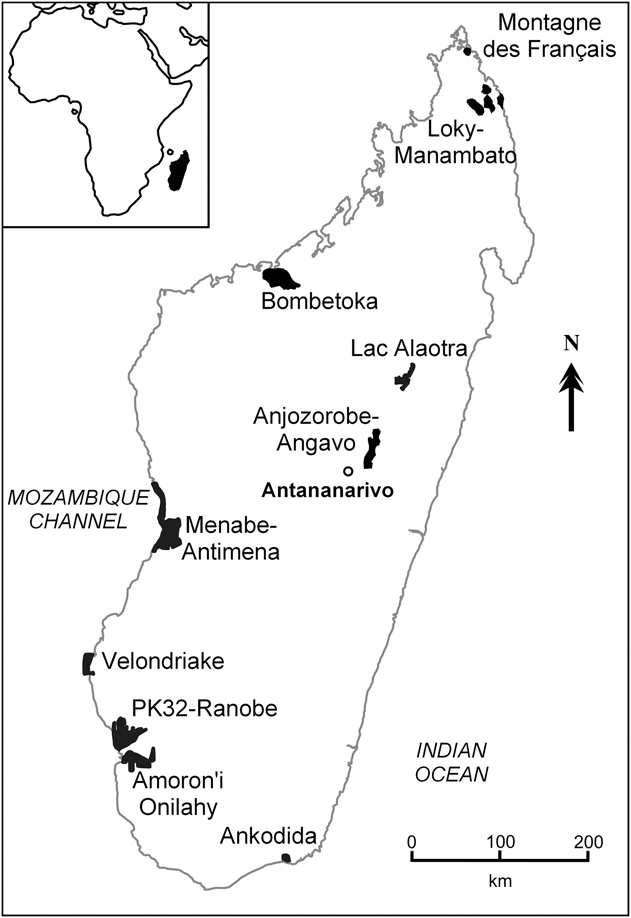
Fig. 1 Madagascar, showing the locations of the 10 case study protected areas (Table 1). The inset shows the location of Madagascar off the south-east coast of Africa.
Table 2 Summary details of the 10 case study protected areas (Fig. 1).
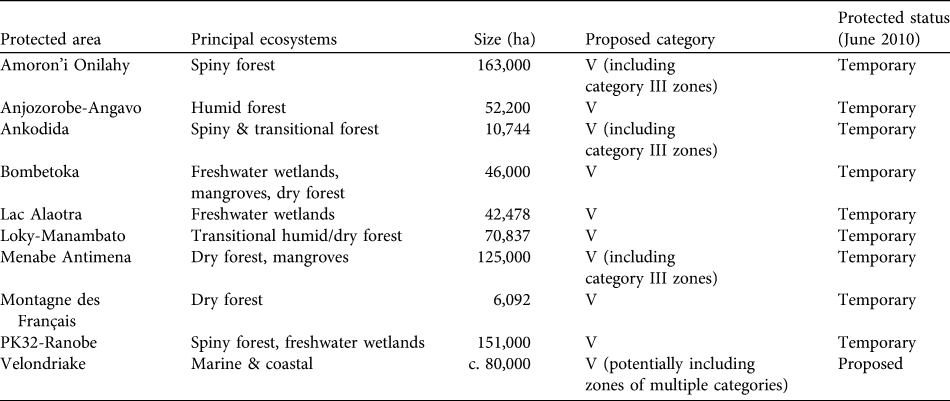
Table 3 Categorization decision-tool showing results of analyses for 10 case study protected areas.
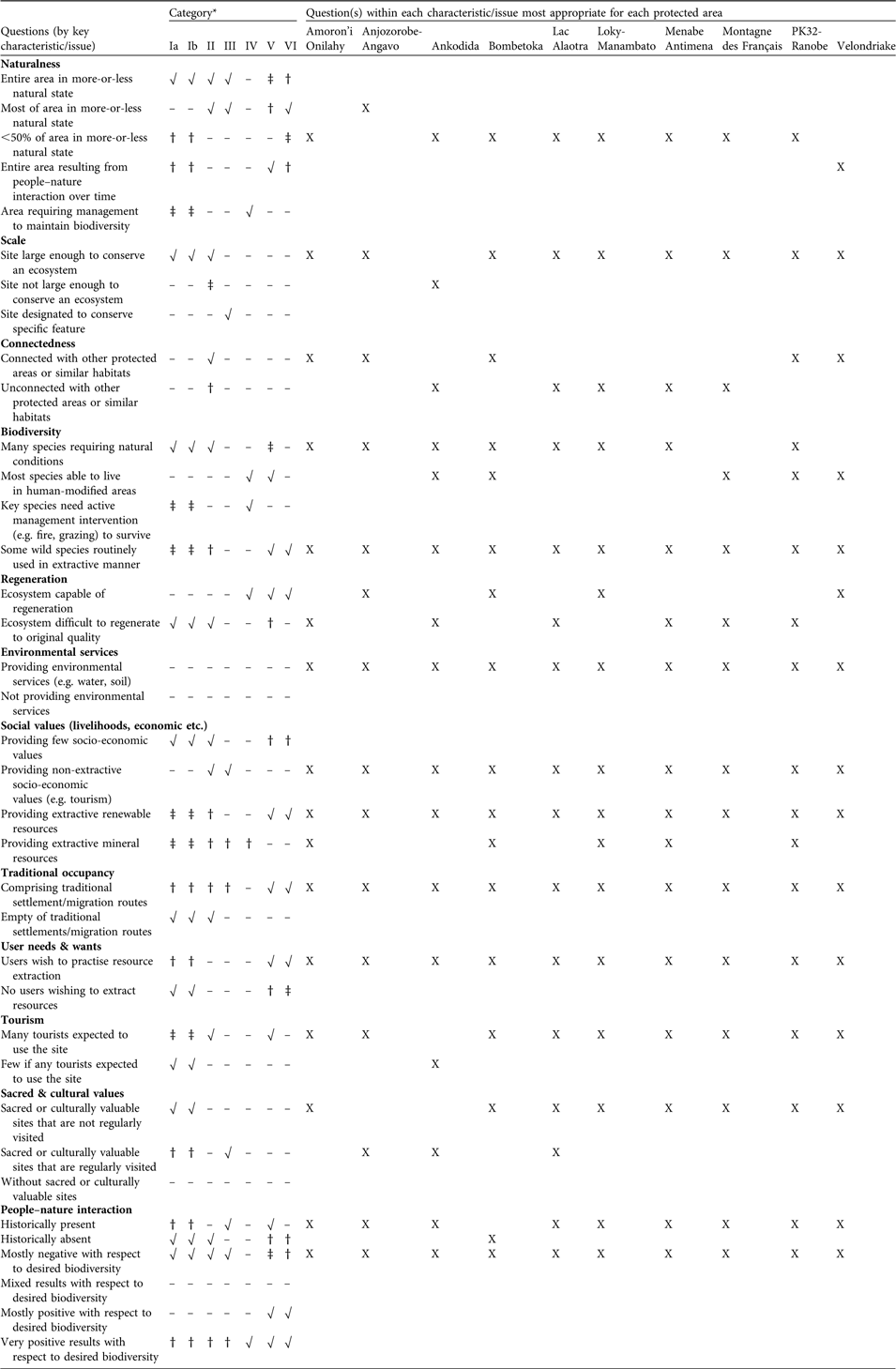
* Compatibility of each attribute state (questions within each key characteristic/issue) with each protected area category: √, particularly compatible; –, not incompatible; †, tends to be incompatible; ‡, never normally suitable
Results
Full results of the categorization scoring system exercise for the 10 case study protected areas are presented in Table 3, and Table 4 gives the total scores for each site by category. In all but one case the scoring system indicates that category V is the most suitable category for these sites. Closer analysis, however, reveals incompatibilities between the case study protected areas and each of the IUCN management categories (Table 5). Principally, their traditional human occupancy and management emphasis on sustainable resource extraction render them incompatible with categories I, II and III, and their focus on landscapes rather than specific habitats or species requiring management is incompatible with category IV: The two highest-scoring categories, V and VI, are those whose objectives are compatible with large-scale natural resource use. I investigate two protected area attributes, naturalness and people–nature interactions, in greater detail as they are critical to the designation of IUCN categories V and VI.
Table 4 Results of categorization decision-tool analyses (see text for further details), showing total scores by protected area (Fig. 1, Table 2) for each category (Table 1).
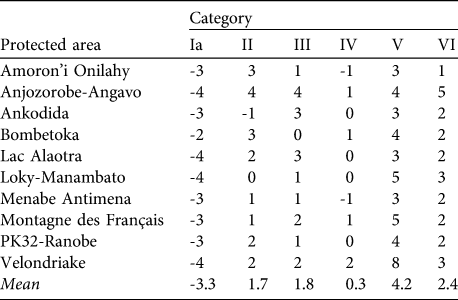
Table 5 Principal sources of incompatibility between case study protected areas and IUCN management categories.
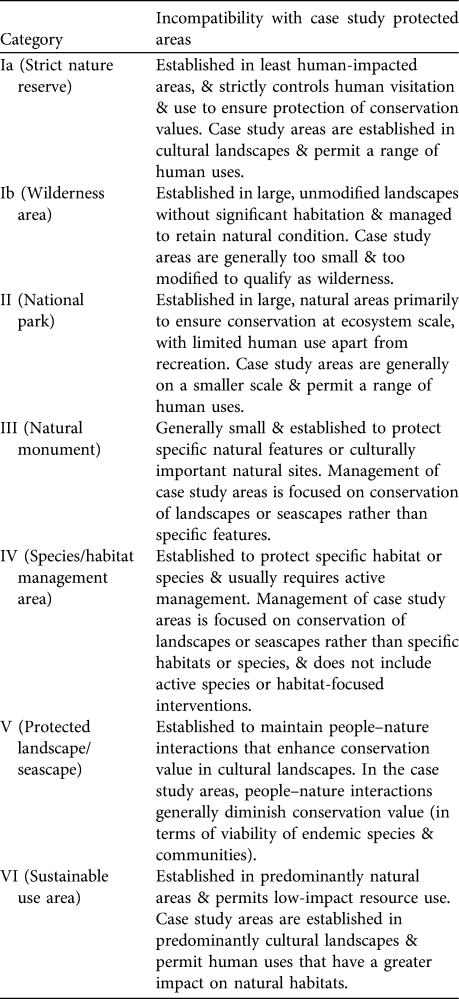
Naturalness
The key difference between category V and VI concerns the degree of human modification of the landscape. Whereas category V is suited to cultural landscapes shaped by human influence over time, category VI guidelines suggest that two-thirds of a protected area should be composed of natural or unmodified areas (defined as ‘those that still retain a complete or almost complete complement of species native to the area, within a more-or-less naturally functioning ecosystem’; Dudley, Reference Dudley2008a, p. 12). The seven terrestrial case studies all probably fail to meet this criterion, having significant areas of deforested land and little undegraded forest within their boundaries; in many cases the limits of these protected areas have deliberately included significant areas of deforested land to permit development interventions within buffer zones of low conservation value. The ecosystems of Lac Alaotra have been altered by marsh drainage and burning, sedimentation and the introduction of invasive plants and fish (Andrianandrasana et al., Reference Andrianandrasana, Randriamahefasoa, Durbin, Lewis and Ratsimbazafy2005; Ranarijaona, Reference Ranarijaona2007), and Velondriake’s ecosystems have been altered by overfishing that has transformed trophic dynamics and provoked phase shifts from coral to algal cover (Harris, Reference Harris2007). Beyond these sites it is debatable whether any area of Madagascar possesses a ‘complete complement of species native to the area’, given the relatively recent (< 2,000 years) extinctions of the island’s mammal, bird and reptile megafauna (Crowley, Reference Crowley2010). All potential conservation areas could therefore be termed cultural landscapes.
People–nature interactions
Human influence on Madagascar’s ecosystems has been largely negative for biodiversity (Gardner, Reference Gardner2009; Irwin et al., Reference Irwin, Wright, Birkinshaw, Fisher, Gardner and Glos2010), with two major impacts apparent: the extinction of the megafauna (Crowley, Reference Crowley2010) and the loss of forest cover. Although the extent of original forest cover is disputed (Virah-Sawmy, Reference Virah-Sawmy2009) up to 84% is thought to have been lost since human colonization, through anthropogenic deforestation (Harper et al., Reference Harper, Steininger, Tucker, Juhn and Hawkins2007). Deforested landscapes comprise primarily species-poor grasslands and bushlands, with little value for endemic biodiversity (Lowry et al., Reference Lowry, Schatz, Phillipson, Goodman and Patterson1997). As the majority of the island’s biota is restricted to forests (Goodman & Benstead, Reference Goodman and Benstead2005), the overall impact of human land-use over the last 2 millennia has been negative for the majority of the island’s endemic species. Two examples from the case studies, Lac Alaotra and Southern spiny thicket, serve to illustrate such impacts.
Lac Alaotra The largest body of freshwater in Madagascar and a Ramsar site since 2003, the lake and its associated marshes include the entire global range of the Critically Endangered Alaotra gentle lemur Hapalemur alaotrensis, as well as the only known breeding area of the now extinct Alaotra little grebe Tachybaptus rufolavatus and (until recently) the Critically Endangered Madagascar pochard Aythya innotata. The human population of the Alaotra watershed increased five-fold from 1960 to 2003 (Bakoariniaina et al., Reference Bakoariniaina, Kusky and Raharimahefa2006). The forested hills of the watershed have mostly been cleared, and subsequent erosion and siltation has resulted in lake acidification and a reduction in lake area to 20% of its original size by 2000 (Bakoariniaina et al., Reference Bakoariniaina, Kusky and Raharimahefa2006). Most of the lake’s marshes have been converted to rice cultivation and remain threatened by burning (Copsey et al., Reference Copsey, Jones, Andrianandrasana, Rajaonarison and Fa2009), introduced plant and fish species have altered aquatic vegetation dynamics, and overfishing remains a serious problem (Andrianandrasana et al., Reference Andrianandrasana, Randriamahefasoa, Durbin, Lewis and Ratsimbazafy2005). This range of pressures on the lake’s ecosystems has had extreme impacts on the locally-endemic biodiversity: T. rufolavatus has not been recorded since 1982 (Wilmé, Reference Wilmé1994; IUCN, 2010) and A. innotata had not been recorded since 1991 and was presumed extinct until recently rediscovered elsewhere (René de Roland et al., Reference René de Roland, Sam, Rakotondratsima and Thorstrom2007). The population of H. alaotrensis has declined from an estimated 10,710 in 1994 to an estimated 2,480 in 2002 (Ralainasolo, Reference Ralainasolo2004).
Southern spiny thicket The spiny thicket ecoregion of southern Madagascar was, prior to the Durban Vision (and the establishment of PK32-Ranobe, Amoron’i Onilahy and Ankodida of the case study protected areas), the least represented biome within the country’s protected area system (Fenn, Reference Fenn, Goodman and Benstead2003a). People–nature interactions within the ecoregion take various forms, including pastoralism, timber and non-timber forest product extraction, charcoal production, and slash-and-burn agriculture (hatsake; Seddon et al., Reference Seddon, Tobias, Yount, Ramanampamonjy, Butchart and Randrianizahana2000; Gardner et al., Reference Gardner, Ferguson, Rebara, Ratsifandrihamanana and Mallarach2008). Although the hatsake system of agricultural production may have been sustainable at low population densities and under certain social institutional conditions (Elmqvist et al., Reference Elmqvist, Pyykönen, Tengö, Rakotondrasoa, Rabakonandrianina and Radimilahy2007), increased rates of forest conversion because of changing macroeconomic conditions (Casse et al., Reference Casse, Milhøj, Ranaivoson and Randriamanarivo2004; Minten et al., Reference Minten, Randrianarison, Méral and Swinnen2006), population growth and increasing migration (Rabesahala Horning, Reference Rabesahala Horning, Goodman and Benstead2003; Kaufmann & Tsirahamba, Reference Kaufmann and Tsirahamba2006) have led to the region suffering the fastest rates of forest loss in the country since 1990 (Harper et al., Reference Harper, Steininger, Tucker, Juhn and Hawkins2007). In the only existing study on the impacts of forest loss on biodiversity within the ecoregion, Scott et al. (Reference Scott, Brown, Mahood, Denton, Silburn and Rakotondraparary2006) found that species richness of lizards, small mammals and birds declined by 50, 40 and 26% respectively, and species turnover also resulted in shifts in community composition from habitat specialists to generalist species. Of the three case studies within the region, all are primarily threatened by hatsake and charcoal production. In all three cases the interaction between people and nature has been negative for the ecological and biological values of the site as well as for certain environmentally favourable cultural values, such as the preservation of culturally and spiritually important forest areas (Fenn, Reference Fenn, Goodman and Benstead2003b; Bodin et al., Reference Bodin, Tengö, Norman, Lundberg and Elmqvist2006; Gardner et al., Reference Gardner, Ferguson, Rebara, Ratsifandrihamanana and Mallarach2008). Other cultural values, however, such as the opportunity to derive a livelihood from ancestral lands (Keller, Reference Keller2008), are enhanced by the interaction.
Discussion
The analysis suggests that the 10 case study protected areas do not fall neatly into any of the IUCN management categories. Of the two categories compatible with large-scale natural resource extraction, category VI appears unsuitable because of the degree of human modification of the land- and seascapes in question, and the negative impact of land and resource use on biodiversity violates the key principle of category V, the category to which they have been proposed. The choice between category V and VI, at least for some terrestrial case studies, is complicated by the deliberate inclusion of degraded and deforested areas within protected area boundaries. Such areas have been incorporated into protected areas because (1) they are seen as valuable for the promotion of economic development to reduce dependence on unsustainable resource use, and (2) they often occur in a mosaic pattern within higher quality habitat, making their exclusion from protected areas spatially complex. Excluding such areas would lead to these sites more closely matching the criteria for category VI, although categorization must be based on site-specific realities, and as such category V remains the most suitable based on the decision-tool analysis. With regards to human impacts on biodiversity, I do not suggest that no examples of harmonious people–nature interactions of the type envisaged in the protected landscapes model exist in Madagascar but rather that the case study areas are not typified by such interactions. Possible examples of harmonious interactions include the sclerophyllous scrub and alti-montane prairies of Andringitra, which are at least partly maintained by cattle grazing and fires (Rabetaliana & Schachenmann, Reference Rabetaliana and Schachenmann1999), the fire-maintained Tapia woodlands of the central highlands (Kull, Reference Kull2004), forest management by Mahafaly pastoralists (Kaufmann & Tsirahamba, Reference Kaufmann and Tsirahamba2006), and the suppression of the invasive endemic vine Sarcostemma viminale (Asclepiadaceae) by cattle grazing within Beza Mahafaly Special Reserve (Sussman & Rakotozafy, Reference Sussman and Rakotozafy1994).
The key difference between category V in Madagascar and the model as conceived and implemented in Europe concerns the role of people–nature interactions within present and future protected area management. In the protected landscapes model human–nature interactions are seen as intrinsic to the landscape and essential for the maintenance of conservation values (Phillips, Reference Phillips2002). In Madagascar, however, such interactions are largely negative for the maintenance of conservation value and, if left unchecked, could result in the near complete loss of natural habitats and areas of high biodiversity value. The justification for protected area creation, therefore, is undermined by the impact of local communities on the landscape. Rather than maintaining the interaction, management of category V areas in Madagascar is focused on modifying and reducing the type and intensity of natural resource use to promote sustainability and minimize the negative impacts of resource use (Harris, Reference Harris2007; Gardner et al., Reference Gardner, Ferguson, Rebara, Ratsifandrihamanana and Mallarach2008). Harmonious people–nature interactions, in these cases, are a desired future state to be fostered, rather than an existing dynamic to be maintained. This distinction is not purely semantic and has real and important management ramifications. In the European model of category V a balanced interaction between man and nature has been reached and the management challenge is to maintain traditional land use in the face of more destructive modern practices (Phillips, Reference Phillips2002). In Malagasy category V areas, however, the interaction between people and nature has not yet reached a balance and the challenge is to adapt these into more benign, harmonious forms before further biodiversity is lost. This fundamental difference in approach is particularly important given that category V has been promoted by the IUCN for adoption worldwide; emphasizing the maintenance of traditional livelihood practices will not result in conservation gains if such practices negatively affect biodiversity and it is therefore essential to distinguish harmonious from negative people–nature interactions both in practice and in theory. Furthermore, the masking of these differences diminishes the utility of the category system as a framework for the description and comparison of protected areas, its primary function.
Given the incompatibilities between Malagasy protected areas proposed as category V and each of the six main IUCN categories, how should these sites be categorized? These protected areas need to incorporate the livelihood needs of local communities in management decision-making and, consequently, must accept certain activities that, unless carefully managed, have the potential to negatively affect the conservation values they were established to maintain. Such protected areas are likely to become more common in an ever-modernizing world in which remaining natural ecosystems become increasingly small and fragmented and where increasing numbers of rural people depend on resources from such areas for their well-being (Mallarach et al., Reference Mallarach, Morrison, Kothari, Sarmiento, Atauri, Wishitemi, Dudley and Stolton2008). My analysis suggests that protected areas established in such a context, where human land and resource use may diminish the viability of species and ecosystems but must nevertheless be accepted in the initial stages of protected area establishment, are not adequately represented by the IUCN protected area management categories. By failing to recognize the fundamental differences between category V protected areas of the type proposed in Madagascar and those prevalent in Europe, the system fails to acknowledge the former for what they are: valuable areas for the conservation of biodiversity that are threatened, rather than maintained, by human agency. Pigeon-holing these sites into other categories may result in failures amongst conservation scientists, practitioners and policy-makers to recognize the critical role played by this emerging type of protected area in maintaining biodiversity while promoting development within human-dominated landscapes, as well as the immense challenges associated with achieving such outcomes in these circumstances.
I therefore suggest that the IUCN category system be modified to recognize formally the intrinsically different nature of such protected areas. Two possibilities suggest themselves: (1) That the definition of category V be relaxed so as to reduce the emphasis on people–nature interactions that are positive for biodiversity and to include all protected areas in which people–nature interactions (of any type) are dominant features of the landscape. Rather than insisting on the existence of a harmonious people–nature interaction as a key criterion of a protected landscape, guidelines could simply require the potential for such an interaction to be restored or fostered. (2) That an additional category or subcategory (such as Vb) be created and defined so as to account specifically for the types of protected area in which human–nature interactions must be transformed rather than maintained to meet protected area management objectives.
Of these proposals (1) would meet the goal of recognizing new protected areas of the type prevalent in Madagascar but would nevertheless fail to make the distinction between them and category V protected areas as managed in Europe. Proposal (2), however, would specifically recognize the unique management objectives and approach of Malagasy-type protected areas, a necessary first conceptual step if we are successfully to employ the protected area approach to conserve biodiversity in human-dominated landscapes.
Acknowledgements
I thank Martin Nicoll, Mamy Nirina Razafindrakoto, Eric Rasolondranaly, Sébastien Wohlhauser and Herizo Andrianandrasana for help in completing the decision-tool analyses for the case studies, and Nigel Dudley, Barry Ferguson, Douglas MacMillan, Martin Nicoll, Nanie Ratsifandrihamanana, Louise Jasper and Bob Smith, whose insightful comments helped improve this article.
Biographical sketch
Charlie J. Gardner’s research focuses on reconciling biodiversity conservation and rural development within new protected areas in southern Madagascar, using a range of ecological, anthropological and economic approaches, and on protected area management planning with a focus on sustainability.










